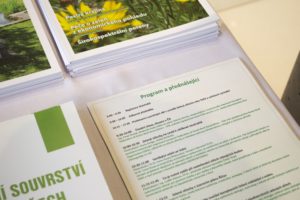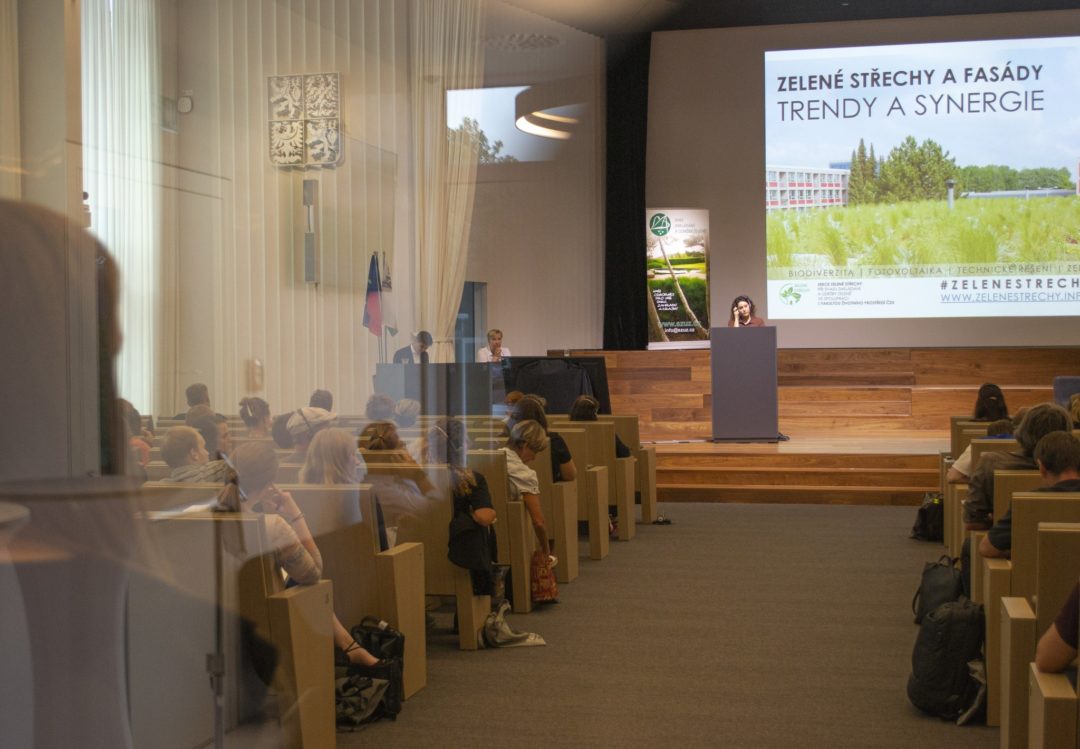Green Roofs And Facades – Trends And Synergies Conference took place in Prague
The Czech Green Roof Association under the Czech Landscape Gardening Association in cooperation with the Faculty of Environmental Sciences of the Czech University of Life Sciences organized an international conference Green Roofs and Facades – Trends and Synergies.
The conference took place on September 8, 2022 in the auditorium of the Czech University of Life Sciences in Prague.

Green roofs provide a range of benefits not only to the building owner and user, but also to society as a whole. They provide an efficient way of managing rainwater, heat savings, contribute to improving the urban microclimate or reducing the urban heat island effect. Last but not least, they serve as an aesthetic element of a building or a place of residence. Approaches to roof greening around the world have been changing recently, with new concepts emerging such as biodiverse green roofs, biosolar green roofs of blue-green roofs. These new concepts also correspond to new technologies and approaches to roof and facade greening.
The main goal of the conference was to raise awareness among responsible representatives of municipalities and government officials in cities and municipalities, as well as the professional public, about new trends in the field of greening roofs and walls of buildings as one of the adaptation measures to climate change.
The conference was aimed at representatives of the state administration, municipalities, designers, construction and gardening companies, developers.

The topics of the conference were:
- Green roofs and biodiversity
- Green roofs and photovoltaics
- Green roofs and rainfall
- Green facades

At the end of the conference, the results of the Green Roof of the Year 2022 competition were announced.
Programme and speakers
Introduction, situation in the Czech Republic
Ing. Pavel Dostal, Chairman of the Council of the Professional Section of Green Roofs, Vice President in the international organization European Federation of Green Roof Associations – EFB, managing director of the company GreenVille service s.r.o. /www.zelenestrechy.info/
Green roofs on the path to carbon neutrality
Can we create carbon neutral green roofs using materials and products that capture or offset carbon? How can this approach be combined with the use of regional/local vegetation that contributes to biodiversity? How we can use satellite imagery and artificial intelligence to map the potential of carbon-neutral green roofs and to monitor the performance of green roofs while meeting EU biodiversity targets.
Lecturer: Dusty Gedge, (UK). President of an international organisation European Federation of Green Roof Associations – EFB, Member of the Board of Directors Green Roof Organisation (GRO), expert on green roofs and urban green infrastructure, photographer and nature conservationist https://dustygedge.co.uk
Vienna’s experience with the development of green facades
The lecture provided a brief overview of the development of green facades in Vienna in terms of political approach, legislation and standards. Participants learned about examples of older and newer implementations of vertical greenery, including technical details. There also was information on current research projects.
Lecturer: Dr.-Ing. Irene Zluwa (Austria), GrünStattGrau innovation laboratory. Landscape architect and researcher focusing on greening of buildings. She gained her experience in various projects related to green roofs and vertical greenery at the University of Natural Resources and Life Sciences in Vienna and now works in the Austrian Innovation Laboratory for Greenery on Buildings GrünStattGrau, which, as a comprehensive competence centre, promotes innovations for the green and smart city of the future and puts them into practice.
What to consider when greening the roofs of existing buildings
Lecturer: Ing. Luděk Vejvara, Ph.D., Chairman of the Regional Office ČKAIT Plzeň. Authorized engineer for civil engineering and for the statics and dynamics of buildings, who designs and also lectures on building structures at the University of West Bohemia in Plzeň.
Green roofs in the urban plan of Říčan
Lecturer: Vladimír Kořen, Czech television publicist, moderator, pedagogue. Between 2010 and 2020, he was the mayor of the town of Říčany in the Prague-East district.
Green roofs as part of comprehensive water management solutions
Water availability is often the limiting factor in maintaining plant prosperity on green roofs. The solution may be water management strategies involving a combination of growing substrate characteristics, plant selection, plant biomass coverage, required parameters for rainwater runoff control, evapotranspiration and irrigation. This problem must be solved in a sustainable way by means of innovative green infrastructure (GI), able to increase the water supply in urban systems through the recovery of rainwater and service water and its reuse for irrigation.
Lecturer: Mgr. Michal Šereš, FŽP ČZU, Department of Applied Ecology, technologist in the field of nature-based solutions for wastewater treatment.
Using ecological laws to create biodiverse green roofs
This lecture was aimed to present the basic ecological rules leading to the support of biodiversity in the landscape (including the urban one) and to identify rare species and habitats that could be effectively supported on green roofs. Basic measures/rules that could be used to take biodiversity into account when subsidizing the construction of green roofs were also presented.
Lecturer: Ing. Michal Knapp, Ph.D., Faculty of Environment of ČZU, Department of Ecology, head of the insect ecology team. Ecologist and entomologist interested in promoting insect biodiversity in heavily human-influenced habitats such as agricultural landscapes and urban environments.
Biodiversity on green roofs
The lecture discussed the importance of biodiversity and ways to support it when designing green roofs. Using specific examples, the speaker showed elements and materials that can be used to create diverse conditions on green roofs. Conference participants were also introduced to the Austrian guidelines for dealing with biodiversity on green roofs.
Lecturer: Isabel Mühlbauer, (Austria), GrünStattGrau innovation laboratory. Participates in national and international research projects dealing with the integration of plants into the built environment. Before that she studied and worked on energy-efficient buildings.
Biosolar green roofs – possibilities and potential
Lecturer: Andreas Dreisiebner (Switzerland), member of the board of Solarspar and managing director of A777 Gartengestaltung under the Growsolutions brand , where he implements projects as a general supplier of “energetic” green roofs. Solarspar www.solarspar.ch
Solar communities – initiated and supported by Solarspar – are an ideal example of the promotion of sustainable energy.
Blue-green roofs – a technical view
First, the basics of decentralized rainwater management were presented. After that, the potential of retention green roofs was explained from a technical standpoint. At the end of the presentation, various examples of successfully implemented retention green roofs were presented.
Lecturer: Fiona Wolff, MSc., project manager Bundesverband GebäudeGrün e.V (BuGG), www.gebaeudegruen.info, www.bugg.de, Vice President EFB. Graduated with a bachelor’s degree in nature conservation and land use planning and a master’s degree in land use planning with a focus on green roofs, both at the University of Applied Sciences in Neubrandenburg.
Succession and green roofs
Succession – enemy or tool to achieve the goal? It seems that we live in a time when we no longer try so much to exploit nature, but rather try to humbly imitate it and live with it. The above applies not only to perennial beds close to nature with a high proportion of self-regulation, but also, of course, to green roofs. And it is through self-regulation that nature tries to bring our mistakes back to balance – to climax. Botanists call this path succession. We can fight it or use it. Let’s see which way will be more economical or kinder to the eye and heart.
Lecturer: Ing. Eduard Chvosta, deputy director for horticulture at the Secondary School in Jarov. Expert consultant of ZOO Prague in matters of greenery, preparation and implementation of expositions. Supporter of nature-friendly solutions, modern technologies and sustainable solutions with low input and output “energies”.




